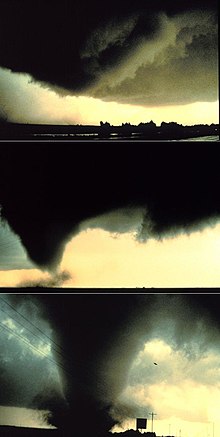


Tornadogenesis is the process by which a tornado forms. There are many types of tornadoes, varying in methods of formation. Despite ongoing scientific study and high-profile research projects such as VORTEX, tornadogenesis is a volatile process and the intricacies of many of the mechanisms of tornado formation are still poorly understood.[1][2][3]
A tornado is a violently rotating column of air in contact with the surface and a cumuliform cloud base. Tornado formation is caused by the stretching and aggregating/merging of environmental and/or storm-induced vorticity that tightens into an intense vortex. There are various ways this may come about and thus various forms and sub-forms of tornadoes. Although each tornado is unique, most kinds of tornadoes go through a life cycle of formation, maturation, and dissipation.[4] The process by which a tornado dissipates or decays, occasionally conjured as tornadolysis, is of particular interest for study as is tornadogenesis, longevity, and intensity.
- ^ Coffer, Brice E.; M. D. Parker (2017). "Volatility of Tornadogenesis: An Ensemble of Simulated Nontornadic and Tornadic Supercells in VORTEX2 Environments". Mon. Wea. Rev. 145 (11): 4605–4625. Bibcode:2017MWRv..145.4605C. doi:10.1175/MWR-D-17-0152.1.
- ^ Trapp, R. Jeffrey; R. Davies-Jones (1997). "Tornadogenesis with and without a Dynamic Pipe Effect". J. Atmos. Sci. 54 (1): 113–133. Bibcode:1997JAtS...54..113T. doi:10.1175/1520-0469(1997)054<0113:TWAWAD>2.0.CO;2.
- ^ Davies-Jones, Robert (28 January 2006). "Tornadogenesis in supercell storms: What We Know and What We Don't Know". Symposium on the Challenges of Severe Convective Storms. Atlanta, GA: American Meteorological Society.
- ^ French, Michael M.; D. M. Kingfield (2019). "Dissipation Characteristics of Tornadic Vortex Signatures Associated with Long-Duration Tornadoes". J. Appl. Meteorol. Climatol. 58 (2): 317–339. Bibcode:2019JApMC..58..317F. doi:10.1175/JAMC-D-18-0187.1.